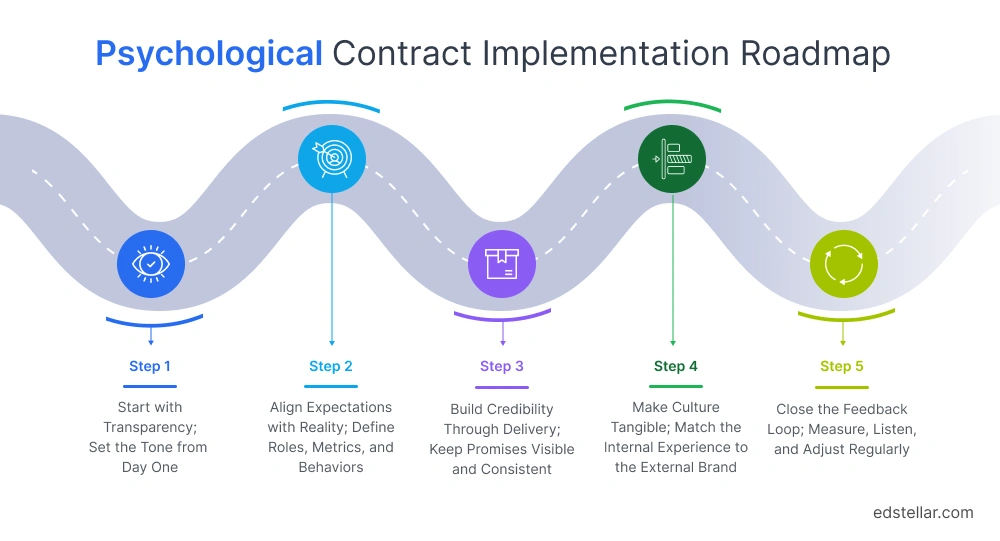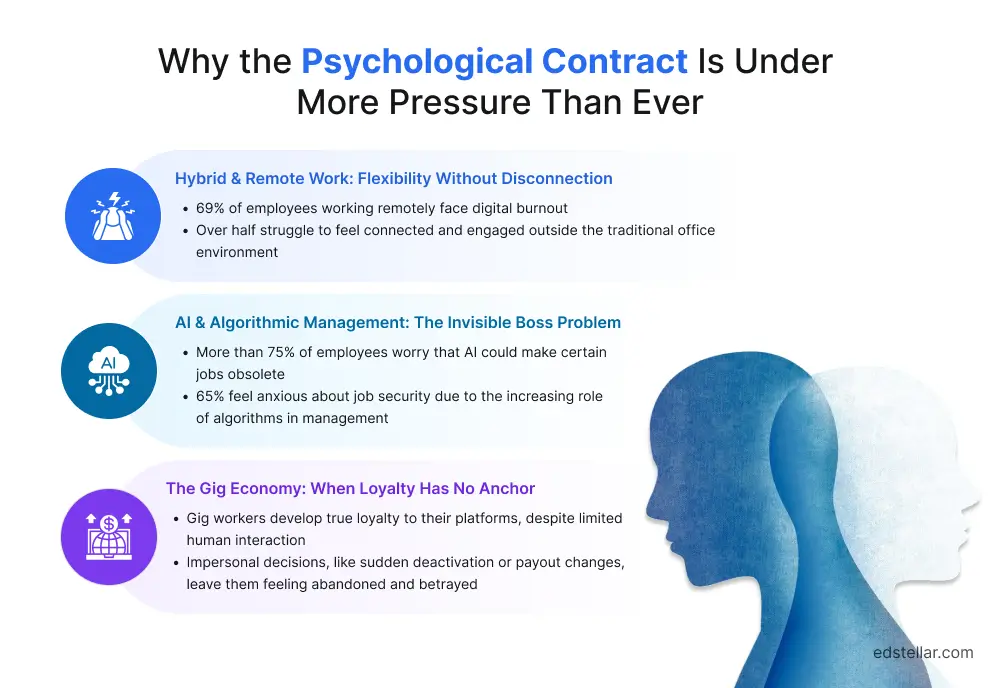
A high performer puts in consistent effort, hits every goal, and then unexpectedly resigns. A new hire, enthusiastic during onboarding, slowly disengages despite no red flags. A team gets everything they asked for: flexibility, tools, and autonomy, but still struggles with motivation. No policies were broken. Nothing visible happened. And yet, something cracked.
What's breaking is the psychological contract, the unwritten understanding between employees and employers. That shapes how people perceive fairness, trust, purpose, and belonging.
Since the pandemic, this contract has been reshaped. Employees aren't just working for compensation or perks anymore. They want alignment with values. They want to matter.
These expectations are not idealistic. They're shaped by the environments leaders create. When there is a misalignment between what is promised or implied and what is actually lived, people tend not to complain. They detach. Quietly. Emotionally. Eventually, completely.
Organizations that understand this are seeing results. According to Accenture, companies offering an "omni-connected experience," where employees feel seen, supported, and aligned regardless of where they work, significantly outperform others in engagement, innovation, and retention.
That's because these companies don't just manage performance; they also manage expectations. The psychological contract is shaped, especially through every one-on-one moment with your employees, that reinforces or contradicts your culture.
In this blog, you'll learn how to spot where trust breaks down at work, how to align expectations from hiring to growth, and how to build a culture that keeps up with change without losing your people.
Let's dive in.
Understanding the Psychological Contract in the Workplace and Why It Matters
The psychological contract can be defined as the unwritten agreement between employees and employers regarding the mutual expectations that exist beyond the formal employee-employer contract. It comprises the beliefs, perceptions, and informal obligations that an employee and an organization assume in their relationship.
What makes the psychological contract so powerful and fragile is its subjective and dynamic nature, formed through workplace interactions, communication, and experiences.
Employees do not respond solely to formal policies. They respond to what they believe has been promised to them. A manager saying, “We always promote internally,” can be interpreted as a future guarantee. An unspoken pattern of flexible work might be taken as a permanent entitlement. These interpretations, especially when left unclarified, create the conditions for future misunderstanding or breach.
Why does this matter? Because the psychological contract governs how employees behave, perform, and stay committed. While official contracts define hours and pay, the psychological contract shapes motivation, loyalty, and trust. These are the invisible drivers of performance. When people feel that their expectations are respected, they do not just work. They engage.
This connection is visible in hard numbers. Gallup’s State of the Global Workplace 2025 report reveals that only 21% of employees are engaged, 62% are not engaged, and 17% are actively disengaged. The cause is often not a missed bonus or broken HR policy. There is a gap between what was implied and what was delivered. Critically, 70% of team engagement is driven by the manager. This shows how day-to-day leadership signals can uphold or damage these unspoken agreements.
When the psychological contract is honored, it leads to tangible business outcomes.
In a market where nearly 50% of employees are open to new opportunities, the psychological contract is a strategic lever for retention, engagement, and cultural health.
How Psychological Contracts are Formed Throughout the Employee Lifecycle
Most organizations don't sit down and "design" a psychological contract, yet every company effectively has one because these contracts form through a series of experiences, messages, and interactions that signal to employees what is valued, rewarded, or tolerated. Crucially, many of these signals are invisible to the organization but very real to the employee.
This case shows how psychological contracts are not always broken by major policy changes or violations. More often, they deteriorate through subtle misalignments, unclear communication, and perceived indifference during moments of vulnerability.
What made her story painful was that no formal promises were broken. But something still cracked, and that crack shattered the glass of trust. That is the nature of the psychological contract.
The Psychological Contract Formation Arc
Understanding this arc provides HR leaders, L&D teams, and managers with a framework to audit and align the psychological signals their organization sends, and to address any disconnects before they erode trust, motivation, or retention.
From Audit to Improvement: Psychological Contract Implementation Roadmap
Creating and sustaining a strong psychological contract is a strategic process of alignment, clarity, and trust-building. For HR leaders, managers, and L&D professionals, the goal is to ensure that the employee experience aligns with the expectations being set and that both parties continuously revisit and uphold their commitments.
Below is a five-step roadmap to create, align, and sustain a healthy psychological contract at work.

Step 1: Start with Transparency; Set the Tone from Day One
The foundation of a strong psychological contract is honest and proactive leadership communication. From the first interaction with candidates and throughout their employee journey, clarity must outweigh convenience. Share important updates, organizational goals, and any planned changes in an open manner. Be transparent about job expectations, performance standards, compensation, and growth opportunities.
For managers, this means engaging in regular two-way communication. Not just routine performance reviews, but genuine conversations that allow employees to express what they expect, what they value, and where they need support. HR teams can reinforce this by encouraging ongoing feedback loops through structured check-ins and anonymous channels. The earlier and more consistently constructive feedback is exchanged, the easier it becomes to manage expectations before they silently diverge.
Step 2: Align Expectations with Reality; Define Roles, Metrics, and Behaviors
Misalignment begins when the employee experience doesn’t match the promises made. To prevent this, job descriptions must accurately reflect the reality of the role, from daily responsibilities and required skills to cultural behaviors, performance metrics, and what success looks like, both formally and informally.
Employees want clarity on how they’ll be evaluated and what kind of behaviors lead to trust and recognition. When this clarity is missing, it opens the door to confusion and mistrust. In fact, a study titled “Strategic Network and Psychological Contract Breach: The Mediating Effect of Role Ambiguity” found that role ambiguity, when employees lack clear expectations about their responsibilities or performance, directly contributes to feelings of unmet obligations and disengagement. In other words, uncertainty around expectations is a major trigger for psychological contract breaches.
For HR, this makes it essential to align hiring managers and team leads to ensure that what’s promised during recruitment is fully delivered in practice. For L&D leaders, it’s a call to embed clear expectations into onboarding journeys, manager playbooks, and development programs so that employees are never left guessing about what success really means.
Step 3: Build Credibility Through Delivery; Keep Promises Visible and Consistent
Trust is not created through intention; it’s earned through follow-through. The fastest way to break a psychological contract is to make promises you can’t keep or to make commitments that never materialize in daily work life.
Employees interpret every promise, whether spoken by recruiters or implied through culture, as a social obligation. As Blau’s (1964) social exchange theory and Gouldner’s (1960) “norm of reciprocity” explain, once something is offered, such as growth, flexibility, or support, people instinctively expect something in return. That expectation, when unmet, isn’t seen as a small oversight. It becomes a breach of trust.
As Shakespeare’s timeless line puts it, “A promise made is a debt unpaid.” In the workplace, these unpaid debts can fracture engagement long before an exit interview.
If you promise training and development, ensure it’s not just available but encouraged. If flexibility is promoted in interviews, your managers must be aligned to support it, not quietly discourage it. If certain behaviors are rewarded, those rewards must be visible and credible across the organization.
Inconsistent behavior between what leaders say and what managers do is one of the most damaging breaches of psychological trust. It signals that messaging matters more than reality.
To avoid this, create alignment across leadership levels and reinforce leadership accountability through effective internal communication, consistent manager coaching, and clear policies that match the organization’s values in action.
Step 4: Make Culture Tangible; Match the Internal Experience to the External Brand
A healthy psychological contract lives inside a strong and aligned workplace culture. And that culture must reflect what your employer brand promises. According to LinkedIn, 83% of talent acquisition leaders agree that an employer’s brand significantly impacts the talent they can attract and recruit. However, attraction without cultural alignment creates expectation gaps that disengage employees early.
HR leaders must regularly assess whether the company’s internal experience reflects its external messaging. If the company speaks about collaboration but rewards individualism, or if it promotes wellness but creates burnout, trust begins to erode. Culture cannot be marketed; it must be lived.
To make culture real, organizations must invest in leadership behaviors, inclusion strategies, psychological safety, and transparent decision-making. Recognize and reward what you want repeated. That’s how culture becomes a reliable part of the contract, not just an abstract value.
Step 5: Close the Feedback Loop; Measure, Listen, and Adjust Regularly
The psychological contract evolves as employees grow, as teams change, and as the business shifts. To keep it strong, organizations need to monitor the health of their contract continuously, not just during exit interviews but while people are still deciding whether to stay engaged.
Use employee engagement surveys, one-on-one conversations, and team-level feedback sessions to uncover whether expectations are being met and where gaps are emerging. According to Forbes, employees who feel heard are 4.6 times more likely to be empowered to perform their best. Listening isn’t just good practice. It’s a core mechanism of contract maintenance.
When feedback surfaces misalignments, such as a need for greater development support or more transparent performance metrics, act on it. Even small adjustments signal to employees that their voices matter, reinforcing mutual responsibility.
Why the Psychological Contract Is Under More Pressure Than Ever
In 2025, the psychological contract between employers and employees is being tested like never before. What once relied on simple, mutual expectations of job security in exchange for loyalty has become vastly more complex in a world shaped by flexible work, algorithmic systems, and platform-based labor.
These evolving dynamics are stress tests for trust, belonging, and perceived fairness, core elements that determine whether people stay engaged or not.
Let's explore three forces reshaping the psychological contract and why they demand urgent leadership attention:

1. Hybrid & Remote Work: Flexibility Without Disconnection
Remote and hybrid models have redefined where and how we work, but they've also blurred the psychological boundaries of work itself.
According to Great Place to Work Australia's 2024 Insights Report, remote work led to a 27% increase in employee engagement and 22% more effort. But that's only one side of the coin.
Forbes Advisor India reports that 69% of remote employees experience digital burnout, and 53% struggle to feel connected, a sign that flexibility alone doesn't guarantee fulfillment. The absence of in-person culture, informal recognition, and visibility can erode the sense of being valued.
Leaders must create intentional structures, including regular check-ins, visible asynchronous contributions, and equitable project distribution, to ensure flexibility doesn't come at the cost of connection or trust.
2. AI & Algorithmic Management: The Invisible Boss Problem
As AI-driven systems take over scheduling, performance management, and even hiring, new risks emerge in the psychological contract: impersonalization, opacity, and fear.
EY's global research found that 75% of employees worry AI will make certain roles obsolete, and 65% are anxious about job replacement. Workers in algorithm-governed environments often feel disconnected, unheard, and even dehumanized. When decisions are made without transparency or room for feedback, it breeds distrust.
Organizations must proactively audit algorithmic systems, offer clear explanations of AI's role, and include employees in ethical AI policy design. Without this, "tech efficiency" may come at the cost of psychological safety.
3. The Gig Economy: When Loyalty Has No Anchor
Gig workers, freelancers, and platform-based contributors may not be "employees" in legal terms, but they still form psychological contracts. They expect fairness, consistency, and recognition. And too often, they get the opposite.
Research in the Human Resource Management Journal reveals that independent workers often form strong psychological bonds with the companies they serve, despite primarily interacting with algorithms. When decisions like deactivation, ranking demotion, or payout changes occur without human context, these workers feel abandoned and betrayed.
The future of the gig economy depends on building trust at scale, with clear communication, dispute resolution mechanisms, and visible support channels. Platforms that treat gig workers as disposable risk alienating the very talent their business models rely on.
Conclusion
The psychological contract isn't abstract anymore; it's operational. It determines whether employees trust their leaders, stay engaged, or quietly check out.
And the people who shape that experience the most? Your managers.
According to Gallup's 2025 State of the Global Workplace report, only 44% of managers worldwide have received any formal training. The cost? Lower team engagement, unclear communication, and broken expectations that never make it into exit interviews.
But there's also a clear upside: trained managers drive up to 22% higher engagement and measurable gains in retention, team performance, and long-term trust.
This is where Edstellar helps organizations take control. With our proprietary skill matrix software, you can assess leadership capability across levels, identify key skill gaps, and deploy tailored training that transforms good intentions into consistent leadership behaviors.
Because today, performance and retention aren't shaped by what's written in policy documents but by the promises people believe you've made and kept.
And you don't have to solve that alone.
If you're ready to rebuild trust, reinforce alignment, and retain the people who matter most, contact us today. Let's design the leadership your people can believe in.
Explore High-impact instructor-led training for your teams.
#On-site #Virtual #GroupTraining #Customized

Bridge the Gap Between Learning & Performance
Turn Your Training Programs Into Revenue Drivers.
Schedule a ConsultationEdstellar Training Catalog
Explore 2000+ industry ready instructor-led training programs.

Coaching that Unlocks Potential
Create dynamic leaders and cohesive teams. Learn more now!


Want to evaluate your team’s skill gaps?
Do a quick Skill gap analysis with Edstellar’s Free Skill Matrix tool

Transform Your L&D Strategy Today
Unlock premium resources, tools, and frameworks designed for HR and learning professionals. Our L&D Hub gives you everything needed to elevate your organization's training approach.
Access L&D Hub Resources.svg)
.svg)



.svg)



.svg)
.svg)
.svg)
.svg)

